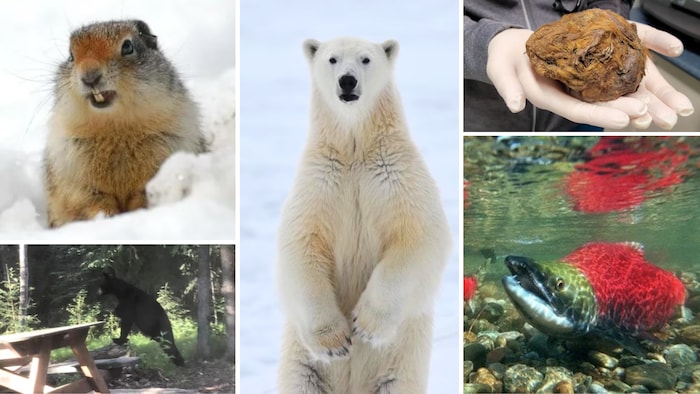Open in full screen mode The year 2023 was rich in animal news. Radio-Canada Voice synthesis, based on artificial intelligence, makes it possible to generate spoken text from a written text. Encounters between wild animals and inhabitants of the Far North attract attention every year. Here are six that particularly piqued the curiosity of readers.
Morgan Watsyk of Fort Simpson, Northwest Territories, spotted a pack of wolves on the road to Wrigley earlier this month and managed to film it.
Morgan Watsyk initially thought he was dealing with mountain goats, but as he got closer, the Fort Simpson resident on his way to Wrigley was in for a complete surprise: it was a pack of wolves!
I was really surprised to see 11 wolves at once. Someone had to be looking out for me that day!
A quote from Morgan Watsyk
Paleontologists estimate that the ground squirrel found near Dawson is approximately 30,000 years old.
It is not uncommon in the Yukon to find Ice Age animals preserved in permafrost. Often, they are mammoths or other large mammals. This time, it was necessary to analyze the specimen using imohSo”>It's not really recognizable until you see the little hands and claws, then there's a little tail and we can see the ears
A quote from Grant Zazula, paleontologist for the Government of Yukon
The animal was actually found in 2018, in the goldfields near Dawson, curled up as if it had died during hibernation. The Yukon government revealed its existence when exhibiting it at the Beringia Interpretive Center in Whitehorse.
Dermot Higgins took this photo of a black bear at his campsite near Carmacks, Yukon. He says he was paralyzed by fear, and traumatized by this encounter in the wilderness.
Dermot Higgins, an Irish tourist, had the fright of his life during a canoe-camping trip on the Yukon River. The man from Dublin was woken up by a black bear and her cub. His bear spray protected the adventurer, not without unfortunate consequences for him.
I don't know how much [pepper spray] hit the bear, or how much I got. I was coughing, I couldn't see anything and I started vomiting.
A quote from Dermot Higgins, Irish tourist
Fisheries and Oceans Canada expects higher numbers of sockeye salmon in the Alsek River this year.
The number of sockeye salmon returning to Yukon's Alsek River is expected to be above average for a second year in a row, but the reasons for the rebound remain a mystery.
Last year, Fisheries and Oceans Canada expected 11,000 sockeye salmon to return for the spawning season in the Alsek River, but the actual number is more double the predictions. It was the highest in over 20 years.
That s& #x27;perhaps explained by a greater survival rate in the ocean, but we don't have definitive answers
A quote from Tom Buzzell, transboundary rivers manager, Fisheries and Oceans Canada
A carnivorous starfish is the Arctic's largest predator, on par with the polar bear, a Canadian research group says. (Archive photo)
The carnivorous starfish is the largest predator in the Arctic, on a foot of x27;equal to the polar bear, affirmed a Canadian research group in a study published in the journal Proceedings of the National Academy of Sciences(New window) (in English).
The study which looked at wildlife life around the world Southampton Island, in Hudson Bay, demonstrated, according to the study authors, that this specific starfish, from the Pterasteridæ family, is the benthic equivalent of the polar bear.
It changes the way we understand how the Arctic marine food chain works. […] We are entitled to the entire food web: predators, herbivores and several carnivores. This is a more complex area than we thought.
A quote from Rémi Amiraux, co-author, University of Manitoba
Due to global warming, female Arctic gophers may wake up too early for the males' sexual capabilities.
< p class="StyledBodyHtmlParagraph-sc-48221190-4 hnvfyV">Scientists studying Arctic squirrels have discovered a surprising consequence of climate change: as temperatures rise, females of this species have gradually brought forward the time when they emerge from hibernation, now shortened by 10 days compared to that of a quarter of a century ago.
The males have not changed their date alarm clock, which threatens to complicate the dates of these little creatures, according to a study published in the journal Science (New window)(in English).
If this continues, females will emerge before males are fully mature for reproduction.< /p>A quote from Cory Williams, study co-author and biologist at Colorado State University

